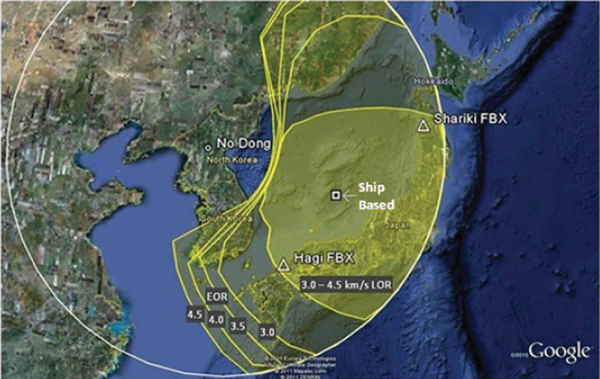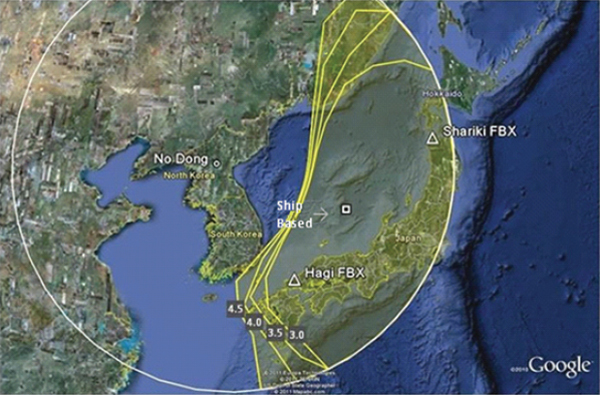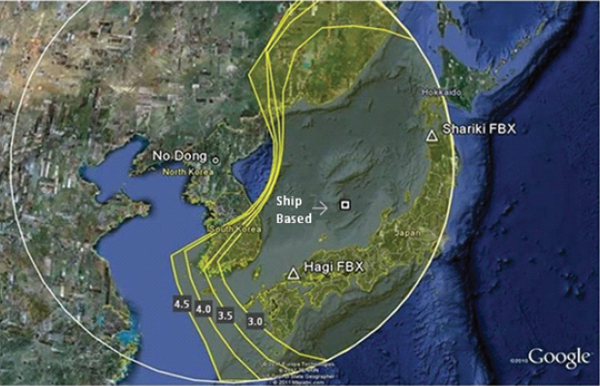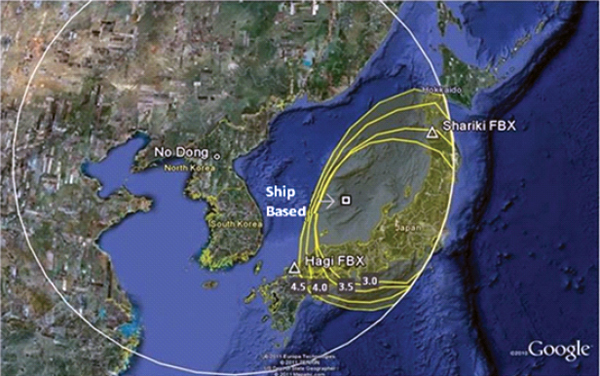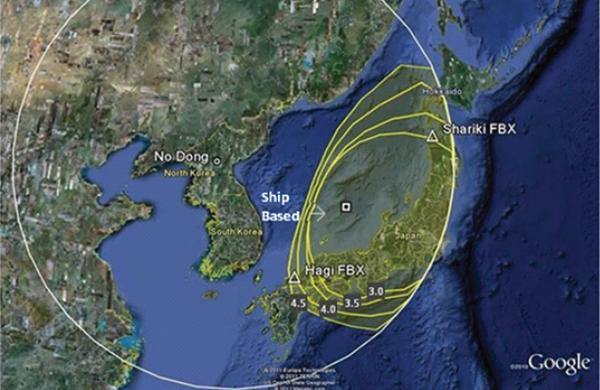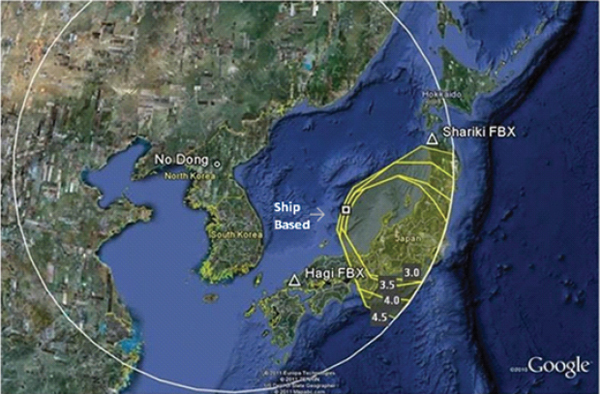3
Alternatives to U.S. Boost-Phase Defense
Table 3-1 displays U.S. boost-phase and non-boost defense alternatives—essentially, present and proposed ballistic missile defense (BMD) systems—that are examined in this report in the context of their potential mission applicability. The non-boost alternatives include the present and proposed systems beyond the boost phase of hostile missile flight—that is, in the ascent or “early intercept” phase, midcourse phase, and terminal phase. This chapter provides additional information on alternative systems to U.S. boost-phase missile defense as requested in the congressional tasking. Specifically, an overview and analysis of the Ground-Based Midcourse Defense (GMD) system; the Aegis ballistic missile defense system, with all variants of the standard missile-3 (SM-3) interceptor; the Terminal High-Altitude Area Defense (THAAD) system; the Patriot (PAC-3) system; and the Medium Extended Air Defense System (MEADS) is provided vis-à-vis their potential mission applicability.
PRESENT AND PROPOSED SYSTEMS
Ground-Based Midcourse Defense System
The 2010 Ballistic Missile Defense Review Report states that “the United States is currently protected against limited ICBM attacks. This is a result of investments made over the past decade in a system based on GMD. Because of continuing improvements in the GMD System and the number of ground-based interceptors now deployed compared to potential North Korean and Iranian long-range ballistic missile capabilities, the United States possesses a capability
TABLE 3-1 BMD Systems Examined in This Report in Terms of Their Potential Mission Applicability
| Protected Area | Terminal | Midcourse | Ascent | Boost | Supporting Sensors |
| Homeland | THAAD ALHK |
GBI MKV SBI KEI |
SM-3 Block IIB KEI SBI ALHK |
SBI ABL KEI ALHK |
DSP/SBIRS UEWR AN/TPY-2 AN/SPY-1 SBX STSS PTSS ABIR |
| Allies | SM-2 Block IV PAC-3 THAAD MEADS |
SM-3 Block I Two-stage GBI SM-3 Block II THAAD |
SM-3 Block IIA SM-3 Block IIB KEI ALHK |
ABL ALHK |
DSP/SBIRS AN/TPY-2 AN/SPY-1 STSS PTSS ABIR Space-ISR A/B ISR |
| Forces | SM-2 Block IV PAC-3 THAAD MEADS |
SM-3 Block I SM-3 Block II THAAD |
SM-3 Block IIA ALHK |
ABL ALHK |
DSP/SBIRS AN/TPY-2 AN/SPY-1 STSS PTSS ABIR RQ-4 MQ-9 |
NOTE: blue, operational; green, in development; purple, being considered; red, inactive, terminated, or redirected.
to counter the projected threat from North Korea and Iran for the foreseeable future.”1
The GMD program provides a ground-based midcourse interceptor for protection of the United States against ICBM threats. The National Missile Defense (NMD) program was established on April 1, 1997, and Boeing was chosen as the lead system integrator (LSI). Supplementing the Boeing effort on the booster, subcontractors include Raytheon for the exoatmospheric kill vehicle (EKV) and the sea-based X-band radar (SBX); TRW and Northrup Grumman for command and control, battle management, and communications (C2BMC); and the U.S. Army Corps of Engineers for construction. Currently, the program is in Phase B (product development), operating with an initial deployed capability. Key
_____________
1Department of Defense. 2010. Ballistic Missile Defense Review Report, Washington, D.C., February.
components of the GMD system include the ground-based interceptors (GBIs), located at Fort Greely, Alaska (FGA), and Vandenberg Air Force Base, California (VAFB); the Missile Defense Integrated Operations Center (MDIOC), located at Schriever Air Force Base, Colorado (SAFB); and the GMD Communication Network.
The GMD system interfaces with the BMD C2BMC system that provides target typing and tracks to the GMD fire control system. Once launched, the GBI communicates with BMD through the GMD fire control system using its in-flight communication system (IFCS) twice during the trajectory fly-out. The GBI interceptors exist in two variants, Capability Enhancement I (CE I) and Capability Enhancement II (CE II); the slight differences in software and hardware result in differences in communication range and discrimination strategies.
At FGA, the GMD system is operated by the 49th Missile Defense Battalion. Currently, Missile Field 1 with 6 silos and Missile Field 3 with 20 silos are operational. Missile Field 2 with 14 silos is under construction. Plans call for Missile Field 1 to be decommissioned following completion of Missile Field 2. At this time, 16 CE I interceptors and 5 CE II interceptors are located at FGA, with most of the interceptors operational at any given time. Additional components at FGA include a GMD fire control and system trainer, two command launch equipment sets, and two IFCSs.
At VAFB, four CE I interceptors are housed among three operational launch facilities, one test launch facility, and one dual-purpose launch facility. VAFB also includes two relocatable IFCS data terminals.
The MDIOC, located at SAFB, contains two GMD fire control and system trainers, which nominally provide for the operational-level command of the GMD system, although the GMD system can be operated from the MDIOC, if necessary. The GMD system components at SAFB are operated by the Missile Defense Element of the 100th Missile Defense Brigade.
The final component of the GMD system is the GMD Communication Network, which is a system consisting of secure fiber- and satellite-communication links. Developed under MDA, the GMD Communication Network will be transferred to the Defense Information System Agency (DISA) in FY 2011 for maintenance and continued development.
In a typical engagement, a threat launch is detected by satellites and the BMD system is alerted. Cues are then issued to radars that detect and establish tracks, and if other criteria are met, interceptor release authority is granted. Engagements are controlled through the interceptor midcourse phase. Following weapons release and the three-stage rocket firings of the GBI, the IFCS is used to relay in-flight target updates (IFTUs) to the EKV and to receive in-flight interceptor status reports during the first communication event (see classified Appendix J for greater detail).
Kinematically, the GBIs have sufficient performance to defend all of the continental United States (CONUS), although the existing system is most effec-
tive for the defense of the West Coast from attacks originating in east Asia. The defense of the U.S. East Coast against attack from southwest Asia suffers from the long duration of autonomous operations following its last IFCS event and the lack of early radar track information.
Table 3-2 lists BMD program investment costs, followed by the GBI average unit procurement recurring cost breakdown of the missile interceptors.
Aegis System and Standard Missile 3 Variants
The Aegis system provides the U.S. Navy with a multimission capability for BMD, antiaircraft warfare (AAW), antisubmarine warfare (ASW), and antisurface warfare (ASuW). With respect to BMD, the Aegis system has an existing capability deployed for sea-based midcourse defense and terminal defense and is in Phase A (concept development) and Phase B (product development) with a family of system improvements at different stages of development. The basic
TABLE 3-2 GMD System Investment Costs Through FY 2009 and Interceptor Average Unit Production Costs (FY 2010 dollars)a
| Program Time Frame | Total Investment (billion $) | Average Annual Investment (million $) | AUPC (million $) | |
| Boost-phase interceptor | 1993-1999 | 1.4 | 227 | |
| NMD DEM/VAL | 1997-2001 | 8.7 | 1,444 | |
| BMD system interceptor | 2003-2009 | 1.9 | 265 | |
| GMD block development | 2002-2009 | 21.7 | 2,716 | |
| Total investment GBI cost elements | 33.7 | |||
|
EKV |
29.8 | |||
|
Boost stack |
19.8 | |||
|
Boost avionics modules |
6.5 | |||
|
Integration, assembly, and test |
14.1 | |||
| Total cost | 70.2 | |||
| Total cost of next five GBIs | 86.5 | |||
aThe current GMD system and previous predecessor system total program acquisition (RDT&E and Procurement) investment sunk costs expended through FY 2009 are based on the sum of the fiscal year actuals reported from the FY 2012 MDA Future Years Defense Plan (FYDP) President’s budget (PB) justification sheets submitted in February 2011 and previous MDA (formerly BMDO) annual PB justification sheets. The committee requested all life-cycle cost elements in constant FY 2010 dollars. MDA provided the committee with both the average unit production costs (AUPCs) for the previous cost for five GBIs and an upper bound estimate for the next five interceptors. Since the GBI costs were unlabeled, the committee assumed they were in constant FY 2010 dollars.
SOURCE: Missile Defense Agency. 2011. Department of Defense Fiscal Year (FY) 2012 Budget Estimates, Justification Book Volume 2, Research, Development, Test, and Evaluation, Defense-Wide Procurement, O&M, and MILCON, Washington, D.C., February.
Aegis system consists of the AN/SPY-1 radar, Aegis BMD signal processor, Mark 41 vertical launch system (VLS), and SM-2 and SM-3 standard missiles. The SM-2 missile is designed for endoatmospheric terminal defense against maneuvering targets, and the SM-3 is designed for exoatmospheric intercepts against ballistic targets.
The Aegis system is capable of operating autonomously using organic sensors against short-range ballistic missile (SRBM) and medium-range ballistic missile (MRBM) threats. Recently, the capability has been added to operate in a launch-on-remote (LOR) mode, whereby the missile launching ship does not maintain its own track of the target at launch but rather uses information from other Aegis or BMD sensors—for example, a land-based Army Navy/transportable radar surveillance (AN/TPY-2) radar. In the LOR concept, the engagement is controlled and in-flight target updates are provided from the launching ship. The Aegis program is also working to develop an engage-on-remote (EOR) capability by 2015, wherein the interceptor can be launched using any available target track and engagement is controlled from in-flight target updates that can be provided to the interceptor missile from any Aegis AN/SPY-1 or AN/TYP-2 radar. By 2015 this projected capability will significantly improve the utlility of the SM-3 Block II in both early and late midcourse engagements.
Since its first successful BMD intercept in January 2002, the Aegis system has undergone an extensive series of flight tests, including tests with no notice to the firing ship (Flight Test Mission (FTM) 04-1, February 2005), against a target with a separating warhead (FTM 04-2, November 2005), in conjunction with coalition partners (FTM 10, June 2006), against simultaneous BMD and AAW threats (FTM 11, April 2007), against dual SRBM targets (FTM 13, November 2007), and using LOR operations (satellite intercept, February 2008). The first fleet firing of the SM-3 occurred during PACBLITZ 08 in November 2008.
The Aegis BMD provides a proven capability for midcourse defense against certain classes of SRBMs and MRBMs. The system has the advantage of being housed on ships, so redeployment of BMD assets is possible, providing flexibility in the defense system. One challenge associated with the integration of the BMD capability on the Aegis multimission platform is that the competing missions may sometimes require deployment in nonideal locations from the BMD perspective.
Kinematically, the Aegis interceptors have about 50 percent of the burnout velocity provided by the GBI, which results in a more limited defended area, and its smaller kinetic-kill vehicle (KKV) divert capability requires more accurate target tracking prior to committing the SM-3 interceptor missile.
The standard missile SM-3 Block IA interceptor missile together with Aegis weapon system (AWS) 3.6.1 is currently deployed for defense against short- and medium-range ballistic missiles and has a limited capability against intermediate-range ballistic missiles (IRBMs). Initially deployed in 2006, 112 missiles will be acquired by the end of FY 2012.
The SM-3 Block IA missile is launched from the Mk-41 VLS and consists of
a 21-in. diameter Mk 72 booster, a 13.6-in.-diameter Mk-104 dual-thrust rocket motor (DTRM), a 13.6-in.-diameter third-stage rocket motor (TSRM), and a kill vehicle (KV) that uses a solid divert and attitude control system (DACS) and a one-color sensor. The KV maintains continuous communications with the launch platform throughout its full trajectory. AWS 3.6.1 retains the multimission capability for AAW, ASW, and ASuW. Following launch of the SM-3 Block 1A, the missile is command guided through its first three stages.
The sea-based terminal Aegis capability is provided using the SM-2 Block IV missile. Originally deployed in 2008, this system has performance against SRBMs and MRBMs. The SM-2 Block IV interceptor consists of the Mk-72 booster, Mk-104 DTRM, a blast fragmenting warhead, and a semiactive guidance system. The SM-2 Block IV missile provides an endoatmospheric intercept capability against maneuvering targets. A long-term replacement for the sea-based terminal interceptor is currently under development in a Phase A (concept exploration) program. This interceptor may also have some limited boost-phase defense capability against boosting targets in the atmosphere, provided the ship is close to the target missile launch location.
Table 3-3 lists the total investment cost of approximately $17 billion and the average annual investment costs for the previous and current BMD Aegis programs from FY 1964 through FY 2009. The table includes all the predecessor program investments beginning with the initial Navy-funded investments in the Aegis program, which consisted of both the development of the SM-2 (RIM-66C)
TABLE 3-3 Aegis System Investment Costs Through FY 2009 (FY 2010 dollars)
| Item | Program Time Frame | Total Investment (billion $) | Average Annual Investment (million $) |
|
Navy Aegis weapon system (RIM-66C SM-2 and AN/SPY-1A) |
1964-1985 | 2.5 | 115 |
|
Navy Aegis SM-2 Blocks I to IV |
1987-2002 | 1.2 | 140 |
|
Sea-based/Navy theater area TBMD DEM/VAL and EMD |
1993-2002 | 6.2 | 686 |
|
SM-2 Blocks IVA and V and VLS canisters procurement |
1999-2001 | 0.3 | 93 |
| BMD Aegis block development | 2002-2009 | 6.9 | 865 |
| BMD Aegis procurement | 2009 | 0.1 | 103 |
| Total Navy and MDA investment | 16.9 | ||
NOTE: EMD, engineering and manufacturing development.
SOURCE: Missile Defense Agency. 2011. Department of Defense Fiscal Year (FY) 2012 Budget Estimates, Justification Book Volume 2, Research, Development, Test, and Evaluation, Defense-Wide Procurement, O&M, and MILCON, Washington, D.C., February.
missile and the AN/SPY-1A radar beginning in FY 1964 and continuing forward with SM-2 Block I through IV program development efforts through FY 2002. In parallel, the Ballistic Missile Defense Organization (the original name) and now the MDA continued parallel program investments to develop, first, sea-based and Navy theater area ballistic missiles beginning in FY 1993, followed by the procurement of SM-2 Blocks IV and V interceptors as well as VLS canisters in the FY 1999 through FY 2001 time frame.
Phased Adaptive Approach
This new program was announced in September 2009 as a shield against Iranian ballistic missile threats. Referred to as the Phase Adaptive Approach (PAA), the program has two primary objectives that are often merged in public releases, causing confusion: (1) Phases 1, 2, and 3 of PAA are evolutions to provide defense of Europe against MRBM and IRBM threats and (2) Phase 4 of PAA, which is not yet well defined but is specifically aimed at improving protection of the eastern United States against the potential of eventual introduction of Iranian intercontinental ballistic missiles (ICBMs).
PAA reflects a change in the intelligence community’s estimates that indicated an acceleration in the development of Iranian IRBMs and a slowdown in the development of ICBMs. The four-phased approach was planned to begin in 2011 and is projected for completion in 2020.
As discussed later, the committee believes there should be a clear distinction between Phases 1, 2, and 3 and its objectives, on the one hand, and on the other, Phase 4, which adds little or nothing to the defense of Europe and is aimed primarily at adding an early shot opportunity to enhance the defense of the United States. Because PAA is still evolving, the details on siting, host nation support, force structure, cost estimates, command and control, concepts of operations, security, and logistics support were not available to the committee.
Phase 1 was planned to be completed in 2011 and consists of the deployment of Aegis naval assets equipped when necessary with the SM-3 Block 1A for the protection of portions of southern Europe against IRBMs.
Phase 2, projected to be completed by 2015, entails the introduction at sea and on land of the SM-3 Block IB interceptor, which is under development. The land-based sites will significantly improve the defense of NATO nations against IRBMs. Under Phase 2, Aegis BMD 4.0.1 will be certified for use in 2012. Included in this upgrade is the deployment of the SM-3 Block IB interceptor, which is currently being developed in a Phase B (product development) program. The principal changes include upgrading the KV to contain a two-color sensor and a throttleable DACS and modifications of the Aegis system to enable an increase in the number of simultaneous engagements. A total of 324 missiles are to be acquired between FY 2011 and FY 2018.
Phase 3, planned to be completed in 2018, adds the SM-3 Block IIA intercep-
tor and will provide full NATO protection against Iranian SRBMs, MRBMs, and IRBMs (except for eastern Turkey, for which separate defenses would be required because of the potentially very short attack trajectories). Under Phase 3, the Aegis BMD 5.1 system will be certified for use by 2015. This missile is currently in Phase A of cooperative development with Japan. Studies are under way looking at conceptual canisters and boosters that can be operated from either ship or shore. The Aegis ashore program is currently in Phase B (product development) and consists of moving SM-3 Block IIA interceptors and their launching system to ground-based locations to provide greater midcourse intercept capability over large landmasses. Initial deployment is planned for FY 2015 at a single site.
Phase 4 is projected to be completed by 2020 and assumes the deployment of an even more advanced SM-3 with better performance. It is projected to have an ICBM capability and a kill capability for missiles in the ascent phase, and it will further augment the GMD system for the defense of the United States.
Terminal High-Altitude Area Defense System
The THAAD system is being developed to enable both endoatmospheric and exoatmospheric intercepts, primarily of SRBMs and MRBMs. In combination with Aegis, it may also provide defense of high-value, small-area targets against longer-range missiles. The system, which is designed to be deployable on C-17 aircraft, consists of six mobile launchers with eight interceptor missiles per launcher, AN/TPY-2 X-band radar, and the THAAD fire control and communications (TFCC) system housed within two tactical station groups. Plans called for a fielded capability by 2011 with 2 batteries and 50 interceptor missiles available. To date, 10 flight tests have been conducted, with six of six successful intercepts having been executed.
The AN/TPY-2 X-band radar consists of the antenna equipment unit (AEU), the electronic equipment unit (EEU), the cooling equipment unit (CEU), and the prime power unit (PPU); it serves both search and fire control functions.
The TFCC consists of the tactical operations station (TOS), the launch control station (LCS), the antenna support vehicle (ASV), and the cable support vehicle (CSV).
The interceptor missiles consist of a single-stage solid rocket with thrust-vector control and a KV that can maneuver both above the atmosphere as well as in the upper endosphere. The KV has a liquid bipropellant DACS, communications transponder and antenna, uncooled sapphire window, and a single-color midwave IR gimbaled seeker.
An engagement begins with the AN/TPY-2 radar, through either cueing or through its surveillance, detecting, and initiating target tracks. The radar collects medium-band and wide-band target features for discrimination before the interceptor is released by the TFCC. A target object map (TOM) is developed from the radar and the designated target is identified. As many as seven IFTUs are
TABLE 3-4 THAAD System Investment Costs Through FY 2009 (FY 2010 dollars)
| Item | Program Time Frame | Total Investment (billion $) | Average Annual Investment (million $) |
|
THAAD DEM/VAL, EMD, and P3I (including ground-based radar) |
1992-2003 | 9.6 | 872 |
| THAAD block development | 2004-2009 | 6.7 | 1,123 |
| THAAD procurement | 2009 | 0.1 | 106 |
| Total Investment | 16.4 | ||
SOURCE: Missile Defense Agency. 2011. Department of Defense Fiscal Year (FY) 2012 Budget Estimates, Justification Book Volume 2, Research, Development, Test, and Evaluation, Defense-Wide Procurement, O&M, and MILCON, Washington, D.C., February.
provided during the interceptor fly-out. Final target discrimination is achieved through TOM alignment and onboard IR discrimination.
The THAAD system investment began with the Ballistic Missile Defense Office funding a demonstration and evaluation (DEM/VAL) program beginning in FY 1992 and continuing through an engineering and manufacturing development (EMD) program through FY 2003 for the missile system, which includes the tactical support group (TSG), launcher, and ground-based radar. Table 3-4 lists the total annual investment of over $16 billion in the THAAD system from FY 1992 through FY 2009. This investment includes the average annual investment over the first two phases of the development program through preplanned product improvement of $872 million over this initial 12-year time frame, followed by the MDA THAAD block development program continuing through the 6 years from FY 2004 through FY 2009 at an approximately 29 percent higher annual investment of over $1.1 billion per year. As of the MDA FY 2011 FYDP budget, the THAAD program is completing development and being deployed. The program began expending procurement funds in FY 2009 for low-rate initial production (LRIP). Even though the first 50 THAAD interceptors were produced using RDT&E funds, the average missile unit costs are based on reported annual procurement budgets and lot quantity buys beginning in FY 2010 and continuing at the rate of 72 per year from FY 2013 through FY 2015.
Patriot System
The PAC-3 system allows the U.S. Army to provide air defense protection against TBM threats, air-breathing threats (ABTs), and cruise missile (CM) threats to critical assets and maneuver forces belonging to a corps and to echelons above corps.
The PAC-3 achieved initial operating capability (IOC) in June 2004 with a full battalion consisting of fire units and missiles. A firing battery consists of a multifunctional phased-array radar set (RS), an electronic power plant (EPP), an engagement control station (ECS), and two dual-capable PAC-3 launcher stations. A radar provides surveillance and missile guidance from launch through midcourse maneuver, terminal engagement, and intercept.
Following target acquisition by the radar, the target trajectory and intercept point are supplied by the fire control system. The missile is launched with an inertial fly-out toward the predicted intercept, with command guidance during midcourse. Following onboard acquisition of the target, terminal homing is provided using rapid response attitude control thrusters with the active missile seeker providing the necessary guidance accuracy. In the endgame following final homing maneuvers, the lethality enhancement system is fired.
The PAC-3 has conducted 31 successful flight tests since 1997 for an average of more than two flight tests per year. There were also four PAC-3 missiles launched at TBMs in 2003 during Operation Iraqi Freedom. An improved version of the PAC-3 missile, called missile segment enhancement (MSE), is currently in development. Higher altitudes and longer intercept ranges will be achieved using a new dual-pulse rocket motor. The MSE will also include a redesigned lethality enhancement system.
Table 3-5 summarizes the total DOD and U.S. Army investment of close to $16 billion from FY 1983 through FY 2009 beginning with the PAC-3 development program and continuing forward for 21 years to FY 2003 at an average investment of $183 million per year. Since FY 2004, the investment in PAC-3 was and still is primarily the responsibility of the U.S. Army (as highlighted in the table), including the commitment of procurement funding for producing a total of 975 missiles through FY 2009. The Army’s LRIP of PAC-3 missiles began
TABLE 3-5 PAC-3 System Investment Costs Through FY 2009 (FY 2010 dollars)
| Program Time Frame | Total Investment (billion $) | Average Annual Investment (million $) | |
| PAC-3 RDT&E (defense-wide) | 1983-2003 | 3.8 | 183 |
| Army PAC-3 RDT&E | 2004-2005 | 0.2 | 122 |
| Army PAC-3 procurement (QTY = 975) | 1997-2009 | 9.0 | 696 |
| Army PAC-3 modifications | 2000 (est.)-2009 | 2.8 | 282 |
| Total DOD and Army investments | 15.7 | ||
SOURCE: Missile Defense Agency. 2011. Department of Defense Fiscal Year (FY) 2012 Budget Estimates, Justification Book Volume 2, Research, Development, Test, and Evaluation, Defense-Wide Procurement, O&M, and MILCON, Washington, D.C., February.
in the fourth quarter of FY 1999 and the first unit was delivered in September 2001.2 The system IOT&E was completed by September 2002 and IOC was declared in June 2004. Operations central (OC) was achieved when the first PAC-3 operational battalion was fully equipped with five fire units (FUs) and 32 PAC-3 missiles per FU. By the end of FY 2003, 268 missiles had been produced, and the U.S. Army procured another 707 missiles through FY 2009.
Medium Extended Air Defense System
MEADS is or was a trinational codevelopment program that aimed to meet the future air and terminal missile defense needs of the United States, Germany, and Italy. As such, it was envisioned as a replacement for the Patriot, Hawk, and Nike Hercules systems. The program was directed and administered by a trinational steering committee. The U.S. MEADS program office executed the day-to-day management on behalf of the U.S. steering committee member.
MEADS has tenuous support in the United States, and the limited data and justification provided to the committee were therefore not analyzed. Originally awarded in 2004, the program had an objective for U.S. IOC in 2017. The system was being designed to have capability against theater ballistic missiles (TBMs), manned aircraft, cruise missiles, unmanned aerial vehicles (UAVs), and tactical air-to-surface missiles.
Within MEADS, a typical fire control unit would consist of two BMC4I systems, a surveillance radar, two multifunction fire-control radars, six launchers with 48 interceptors, and three reloaders. The pulsed Doppler surveillance would operate at UHF and provide 360-degree coverage using a phased-array antenna. The multifunctional fire control radar would operate at X-band with a phased-array antenna and would also provide 360-degree coverage.
ANALYSIS
As previously noted, this study is focused on assessing U.S. boost-phase missile defense and non-boost defense alternatives to countering the threats identified in the congressional tasking (e.g., SRBM, MRBM, IRBM, and ICBM threats) in terms of their ability to carry out the established missile defense missions, all of which are congruent with those established in 2010 by the DOD in its ballistic missile defense report:3 (1) protection of the U.S. homeland against nuclear attacks, other weapons of mass destruction (WMD), or conventional ballistic missile attacks; (2) protection of U.S. forces, including military bases, in
_____________
2The majority of the PAC-3 historical information was based on the Patriot PAC-3 Dec-09 Selected Acquisition Report (SAR) and the Army FY-11 RDT&E and Procurement Budget submitted in February 2010.
3See Department of Defense, 2010, Ballistic Missile Defense Review Report, Washington, D.C., February.
theaters of operation against ballistic missile attacks; and (3) protection of U.S. allies, partners, and host nations against ballistic-missile-delivered WMD and conventional weapons.4 A fourth mission was considered as a collateral benefit but not as a requirements-defining mission: protection of the U.S. homeland, allies, and partners against accidental or unauthorized launch.5,6
Over the course of this study, several tools were used to explore attributes of the existing system, to evaluate potential increments to the existing system, and to assess the performance of a modified system using new conceptual designs. The classified annex that accompanies this unclassified report provides a detailed analysis of the present and proposed systems for U.S. boost-phase missile defense and non-boost alternatives in the context of their potential mission applicability. The following section provides an unclassified analysis that is based on a notional set of threat missiles, interceptor designs and sensors where fly-out velocity has been varied parametrically to explore the basic physical limitations of missile defense system performance. Findings are then provided. In Chapter 4, a summary table of the systems for U.S. boost-phase missile defense and of non-boost alternatives is provided, in addition to other unclassified information.
Homeland Defense: GMD and PAA Phase 4 and Early Intercept of Threats Against the Eastern United States
GMD System
The GMD system as currently configured has the kinematic capability of GBI to defend large geographic areas if early threat track data of sufficient quality can be provided for interceptor commit. The current GMD system configuration is northeast Asia-centric for defense of the western part of CONUS and Alaska. Moreover, it is limited to an inefficient firing doctrine. Currently, there are limitations in protecting the eastern United States from a threat from the Middle East, as detailed in classified Appendix J. The boundaries of the existing GBI kinematic performance envelope are established by the powered-flight exclusion zone (com-
_____________
4For brevity, missions (2) and (3) are usually considered together because they so often defend against hostile missiles of similar character although being defended against for different purposes.
5Any BMD system would provide some inherent capabilities for defense against accidental or unauthorized launch of a Russian or Chinese missile or, for that matter, one owned by another power. However, defense against such attacks should not drive the design or evaluation of defense concepts, because the greater sophistication (or numbers) of such an attack would tend to establish unrealistic and perhaps infeasible or unaffordable requirements compared to those appropriate for a defense focused on the rogue state threat.
6Aside from political and stability effects, such defense is not practical, given the size, sophistication, and capabilities of Russian and Chinese forces and both countries’ potential to respond to U.S. defense efforts, including by increasing the size of the attack to the point at which U.S. defenses are simply overwhelmed by numbers. The fourth mission is discussed in greater detail in the classified annex (Appendix J).
monly referred to as the interceptor “dead zone”) around the interceptor launch location shown as the notch around the origin (see Figure J-1 in Appendix J of the classified annex). The maximum interceptor time of flight and burnout velocity establish the outer boundary. The size of the powered-flight exclusion zone is established by the GBI burnout velocity and total burn time of the booster including any coast periods between stages and EKV separation from the final stage plus the minimum time it takes to orient the EKV and engage the target. A minimum EKV operation time results in a second powered-flight exclusion boundary. The outer boundary is driven primarily by EKV coolant supply and the useful life of the thermal batteries used to power the guidance and control systems on the EKV. However, in a tactical engagement situation, many other factors may come into play that reduce the outer boundary of the kinematic envelope. Examples include interceptor launch delays caused by weapons release authorization; availability of data on launch quality from the forward sensor; communication link limits of the IFICS data terminals (IDTs) in providing IFTUs and TOM handovers to the EKV for acquisition and target discrimination; sun, moon, and Earth limb viewing avoidance during EKV target acquisition and homing; and maximum divert capability of the EKV to take out initial interceptor targeting errors. The lower boundary is at an altitude to ensure that the EKV is above the sensible Earth atmosphere for reliable LWIR sensor performance.
The implications of these limiting boundary conditions are that a powered-flight exclusion zone eats up the battle space around the threat midcourse trajectory. Significantly shorter burn boosters and shorter launch decision delays would improve engagement performance. Long-time-of-flight complications can be removed by having multiple widely dispersed interceptor sites to reduce the need for extremely long-range, long-time-of-flight interceptor trajectories, which permits an SLS firing doctrine as opposed to a wasteful salvo firing doctrine, as discussed in classified Appendix J. It also permits more data collection on decision time and target for more accurate and reliable intercepts.7 While it is kinematically possible to defend the eastern part of CONUS against threat ICBMs from the Middle East using GBI sites at FGA and VAFB, an additional GBI site located in northeastern CONUS would be much more effective and reliable and would allow considerably more battle space and firing doctrine options. The current GMD system architecture must be and can be fixed, as discussed in Chapter 5.
_____________
7In the 2011 Defense Science Board Task Force Report on Science and Technology Issues of Early Intercept Ballistic Missile Defense Feasibility, it was noted, among other things, that “If, as an alternative to simply firing salvos of defense missile at each incoming missile, time is available to fire one missile, observe what happens from that engagement, and then fire the remaining missile(s) only if the assessment is made that the first shot was not successful, then the potential exists to save significant defense resources.” 2011 Defense Science Board. Defense Science Board Task Force Report on Science and Technology Issues of Early Intercept Ballistic Missile Defense Feasibility. Office of Under Secretary of Defense for Acquisition, Technology, and Logistics, Washington, D.C., September.
Early Intercept of Threats Against the Eastern United States: Phase 4 of PAA
Separate and distinct from Phases 1, 2, and 3, Phase 4 of PAA has as a long-term objective the provision of “early” intercepts of threats from the Middle East to the eastern United States, which is poorly protected by the current GMD system. This is a complex issue for three reasons: (1) the limitations of the existing GMD system and the modifications it requires; (2) the size of interceptors needed in Europe to provide an “early” shot without being overflown; and (3) the perceived threat of such interceptors to portions of the Russian Federation’s strategic deterrent force and the effect on U.S.-Russian relations. It seems further complicated by NATO missile defense objectives and how Russian participation in European defense should and could be achieved.
The committee’s assessment of the Phase 4 early intercept augmentation of homeland defense can be summarized as follows. The early intercept of potential threats to the United States would require an interceptor with a fly-out velocity greater than 5 km/sec at the European site to avoid being overflown by modestly lofted threats to the U.S. East Coast. For example, Figure 3-1 shows notional ICBM trajectories headed for the U.S. East Coast flying directly over a notional interceptor with a fly-out velocity greater than 4 km/sec based at the Poland site, but that is less than that which could threaten any portions of the Russian Federation’s strategic deterrent force. A slightly lofted ICBM (solid red) can overfly the kinematic capability of such an interceptor.
The old controversial third site with a two-stage GBI was based on providing such capability. Even then, to provide an early shot ahead of the FGA-based interceptors protecting the western United States, the field of fire of Poland-based interceptors would be constrained to a tail chase engagement geometry to avoid dropping interceptor stages on populated areas of the Russian Federation, another likely bone of contention. Here, a notional interceptor based in Poland such as that described in Figure 3-1 would not threaten any portions of the Russian Federation’s strategic deterrent force, would provide good coverage of Europe, and might be of value to homeland defense under circumstances discussed later in Chapter 5.
If no AN/TPY-2 radar site is available in Turkey, Armenia, Georgia, or another suitable location, the loss of early tracking and discrimination data would preclude the early intercept of threats from Iran to the United States and would erode coverage for European defense.8 One solution would be to base a radar on the Black Sea coast of Romania. However, an AN/TPY-2 at that location would not have sufficient range to avoid being overflown by threats to western Europe, and coverage against MRBM threats would consequently be reduced. Therefore,
_____________
8The Obama administration signed an accord with Turkey in September 2011 for the U.S. military to operate a high-power X-band radar station in Malatya Province, which is approximately 400 miles west of Iran. This new radar capability combined with similar U.S. naval ship radars is expected to provide early warning of Iranian missile activity.
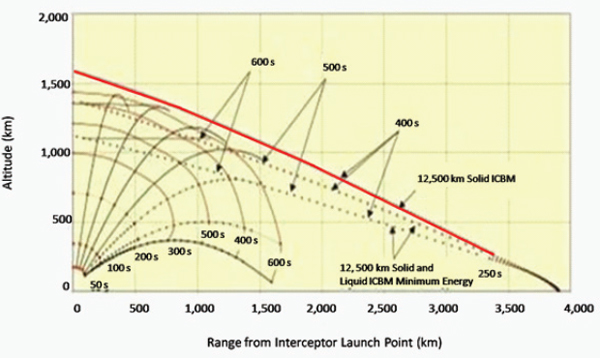
FIGURE 3-1 Notional ICBM trajectories from Iran to U.S. East Coast.
a GBX version, described in Chapter 4, would be required at that location. Another potential alternative being considered by MDA would be a version of the airborne infrared (ABIR) unmanned system flying combat air patrol, perhaps over the eastern Black Sea. Cost should be a strong consideration in the event an alternative to the forward-based radar is needed.
The committee’s analysis suggested that any long-range missiles would likely be based deeper in the heartland of Iran, near Yazd, while shorter range missiles would be based near Tabriz. The basing of ICBMs or MRBMs in silos near Qom raises a question about the value of an Aegis ship in the Black Sea. The committee set aside the obvious operations issues of maintaining an Aegis ship in the southeastern Black Sea in examining engagement effectiveness (see classified Appendix J for greater detail).
Defense of Deployed Forces and U.S. Allies, Partners, and Host Nations
Deployed Forces: Aegis, PAC-3, and THAAD Systems
Against short- and medium-range threats, Aegis, THAAD, and PAC-3 are well developed and suited to their individual missions (e.g., defending deployed forces), but there has been limited interface among them. More attention is needed to the exchange of data and hardware among these systems to take full advantage of the large investment already made in the form of both procurement and operating costs. The newly awarded integrated battle command system
(IBCS) is intended to integrate data from these systems and provide the needed battle management capabilities.
Inputs to the BMD data network already include those from the Defense Support Program (DSP), the SBIRS, and the UHF early warning radars. Maximum use must be made of these data to relieve X-band radars of unnecessary volume or fan search functions, allowing them to concentrate their resources on tracking and discrimination at the longer ranges permitted when properly cued to the targets. This involves little or no new investment.
Despite the recent cancellation of U.S. participation, it should be noted that the MEADS UHF surveillance radar has 360-degree coverage against ballistic missile targets from every direction. It could be a valuable addition to the BMD data network in support of THAAD and PAC-3 by allowing those organic radars to concentrate on fire control rather than also spending resources on surveillance.
A THAAD Block II interceptor has been proposed that would be fast enough to take full advantage of TPY-2 radar coverage. Such an interceptor, if pursued, would expand considerably the defended footprint for THAAD, reducing the number of batteries required to defend large areas against medium-range missiles by as much as 30 percent. A faster THAAD Block II interceptor would take full advantage of the TPY-2 radar. Since THAAD can take advantage of atmospheric filtering, such a THAAD Block II interceptor could provide for extended terminal defense coverage of high-priority targets.
THAAD and Aegis would operate as a layered midcourse defense and THAAD and PAC-3 as a layered terminal defense.
U.S. Allies, Partners, and Host Nations: Phases 1, 2, and 3 of PAA
The early phases of the PAA have remained relatively stable during the course of the study; however, their capabilities have not, particularly as discussions with European allies and the Russian Federation continue. In PAA, the United States has developed a near-term approach for the protection of Europe from now through the relatively near future based on the proven technologies of today as the Iranian MRBM and IRBM threats appear to be developing faster than previously had been envisioned. The proven systems are the SM-3 interceptor, the AN/TPY-2 radar, and, potentially, the airborne IRST sensors. As the threat evolves, extending the mission requirement to defend more or even all of Europe against MRBM and IRBM threats will require three Aegis-class sites still using the SM-3 Block IIA. Coverage of Israel and other Middle East areas against the evolved threat will require two additional sites, still using the same interceptor. (Turkey, of course, will require its separate defense using THAAD or equivalent against shorter-range threats.) These requirements assume single-shot defense of most areas is acceptable. Universal SLS capability—which is desirable for more effective protection—would require additional sites or terminal defense.
As was touched on, PAA has two primary objectives that are often merged
in public discussions. However, there should be a clear distinction between these two objectives because they may lead to different development paths. Specifically, it appears that the first objective (i.e., Phases 1, 2, and 3 of PAA) is to provide an evolutionary protective umbrella for European and Middle Eastern allies initially against SRBM and MRBM threats such as the Iranian liquid-fueled Shahab 3, with a nominal range of about approximately 1,300 km, or the newer two-stage solid-propellant MRBM, estimated to have a range approximately 2,000 km.9 Later on, the capability would be expanded to protect against longer range IRBM threats to Europe. Meeting this first objective would also contribute to the protection of U.S. forces that are within the defended area. These forces and bases (installations), along with other high-value assets, could be further protected by an underlay of THAAD batteries whose radars could also support the LOR capability currently being tested to extend the reach of Aegis interceptors that are planned as the backbone of PAA.
In Phase 1 of PAA, before any new capabilities are available, existing Aegis ships with SM-3 Block 1A interceptors in the eastern and western Mediterranean and the North Sea can provide limited interim protection. If a THAAD radar were placed forward—for example, in eastern Turkey or, as currently in Israel—that radar, cued by SBIRS, would provide LOR data to increase the coverage of the SM-3 interceptors currently constrained by the SPY-1 shipboard radar. In Phase 2 of the PAA, two Aegis ashore sites—one at Deveselu, Romania, and another in northern Poland—are currently planned. Here, AN/TPY-2 radars that are forward based would support LOR capability and possibly EOR capability for Aegis SM-3 Block IB interceptors with improved KVs. Phase 3 of PAA would introduce the higher velocity SM-3 Block IIA interceptor and two new optical tracking systems to support early intercept.
The first of these two new optical tracking systems for Phase 3 of PAA is the Precision Tracking and Surveillance System (PTSS), which is proposed as a constellation of 12 satellites for cold-body tracking. The other proposed optical tracking system is the ABIR system, which is a two- or three-UAV system that is currently being field tested for early stereo threat tracking. As noted in Chapter 4, PTSS seems both unnecessary and far more expensive than other more effective alternative sensors for early track data using X-band radars. As noted in Chapter 4, ABIR is also not well defined.10 Here, the new SM-3 Block IIA inter-
_____________
9Department of Defense. 2010. Ballistic Missile Defense Review Report, Washington, D.C.: February, pp. 5-6.
10The analysis of future ABIR systems in this report is necessarily sketchy because the ABIR program of record was not well defined at the beginning of this study. Initially, the ABIR program was conceived as a Reaper drone using the existing multispectral targeting system (MTS)-B sensor ball as the infrared sensor, possibly with the MTS-B sensor moved toward the nose of the aircraft to allow better elevation viewing. Later the MTS-C sensor ball was suggested to add long-wave infrared (LWIR) capability. Sensors similar to the High-Altitude Observatory 2 (HALO-2) Heimdall sensor have also been suggested. The committee did not attempt to assess the capability of different ABIR
ceptor jointly developed with Japan was planned to provide substantially more performance than the SM-3 Block IA or IB by using a 21-in. second-stage rocket motor; however, it has fallen far short of its originally planned performance.
To meet the first objective of PAA, Phase 3 should include a capability for defending against IRBMs that could put virtually all of Europe and most of the United Kingdom at risk. The committee is aware that Iran appears to be working on larger solid rocket motors. For example, one can construct a notional two- or three-stage solid-propellant IRBM missile based on the same solid-propellant technology Iran has already demonstrated that could have a range of approximately 5,600 km. Such a missile would be capable of reaching virtually all of the Eurasian landmass.
European Defense Analysis
Figures 3-2 to 3-9 illustrate the notional capability expected in the European PAA, where fly-out velocity is varied parametrically. Figure 3-2 displays the ear-
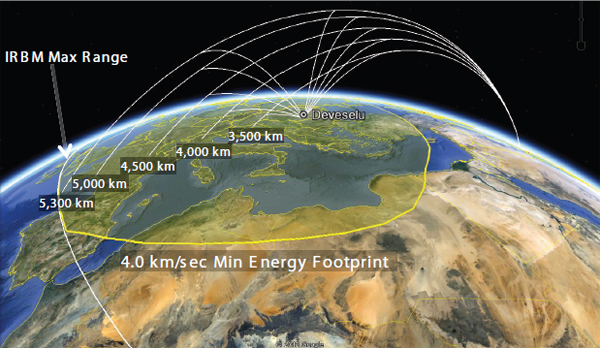
FIGURE 3-2 Notional engagement opportunities of a 4-km/sec fly-out velocity interceptor against minimum energy threats from central Iran flying directly over the planned Deveselu site.
_____________
configurations. However, it should be noted that LWIR capability is essential for cold-body tracking. In addition, tracking through the zenith is required for long-duration midcourse data collection (comparable to requirements for PTSS). Moreover, ABIR LWIR detection ranges should be at least 1,000 km to avoid being overflown by IRBMs. For room temperature targets, this requires sensors with an aperture on the order of 20 cm, assuming that an LWIR system noise equivalent flux density (NEFD) on the order of 1 × 10–16 W/cm2 can be achieved. For colder targets, lower NEFD figures of merit are required, which, in turn, requires cold optics—a potential challenge for airborne platforms. Finally, this system requires that two platforms be airborne simultaneously to provide stereo tracking for range data.
liest and latest engagement opportunities of a notional 4-km/sec fly-out velocity interceptor against minimum energy threats from central Iran flying directly over the planned Deveselu, Romania site. This is the most defense-favorable engagement geometry possible from that site. Figure 3-2 also illustrates that a notional 4-km/sec interceptor at the Deveselu site could provide good coverage and substantial battle space against IRBM minimum-energy trajectories, assuming there is a forward-based radar that provides LOR capability.
Figure 3-3 shows the same interceptor’s performance against trajectories moderately lofted. Such threats, which could reach 4,800 km or more to western Europe, could overfly the kinematic capability of the 4-km/sec interceptor at Deveselu. Thus, in order to protect southwestern Europe and the United Kingdom, one or two additional sites would probably be required if or when the longer range IRBMs emerge. A faster interceptor with a fly-out velocity greater than 5.5 km/sec would have a significantly longer reach and could not be overflown within Europe. This can best be seen by looking at the single-shot- and SLS-defended footprints in Figures 3-2 through 3-17 from notional engagement simulations performed during this study.11
Single-shot coverage defines the maximum boundary of a defended area. SLS footprints delineate the area where SLS doctrine can be enforced. SLS battle space is a measure of robustness, important for allowing a delay in the decision to commit, for second-shot opportunities to take advantage of initial discrimination results, and for replacing intercept failures.
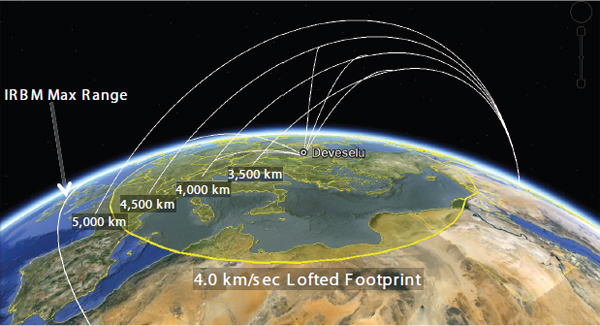
FIGURE 3-3 Notional engagement opportunities of a 4-km/sec fly-out velocity interceptor against moderately lofted threats from central Iran flying directly over the planned Deveselu site.
_____________
11These figures were generated from the committee’s analysis using Google Earth. ©2011 Google, Map Data©2011 Tele Atlas.
Figure 3-4 displays the resulting single-shot coverage for an interceptor with fly-out velocity varied parametrically between 3.0 and 4.5 km/sec in steps of 0.5 km/sec against minimum energy trajectories from central Iran, assuming EOR capability. Figure 3-5 and Figure 3-6 show the corresponding single-shot footprints for lofted trajectories and depressed trajectories, again assuming engage on remote. In all these examples, the western boundary, shown by the white arc, is determined by the maximum range assumed for the notional threat, not by notional interceptor performance.
Figure 3-7, Figure 3-8, and Figure 3-9 show the SLS footprints against minimum energy lofted and depressed trajectories from Iran for three different interceptor fly-out velocities varied parametrically based at Deveselu, Romania, and in northern Poland, assuming EOR. In these cases no 3.0 km/sec interceptor capability was shown because its SLS footprints are either too small or nonexistent.
The message of these figures is that an interceptor with fly-out velocity greater than 4.0 km/sec—and less than that which could threaten any portions of the Russian Federation’s strategic deterrent force and is supported by forward-based X-band radar to provide LOR and EOR capability—provides coverage of all of NATO Europe except eastern Turkey. This message is, however, subject to an important qualification—namely, because the interceptors and sensors could provide coverage of the continent does not automatically mean the defense will be successful. The engagements needed for regional defense will in virtually all cases be in midcourse, and the midcourse discrimination problem is not inherently any different for MRBM or IRBM engagements than for ICBMs. The PAA
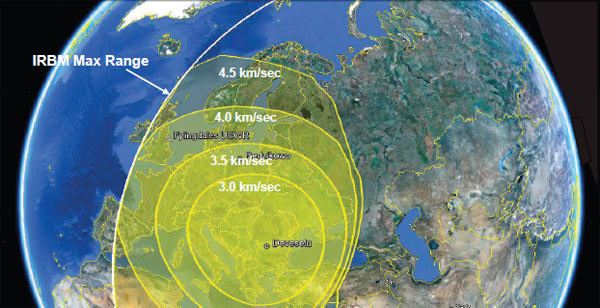
FIGURE 3-4 Notional single-shot coverage for interceptors with fly-out velocity varied parametrically between 3.0 and 4.5 km/sec against minimum energy notional 5,600-km solid IRBM trajectories from central Iran. EOR is assumed.
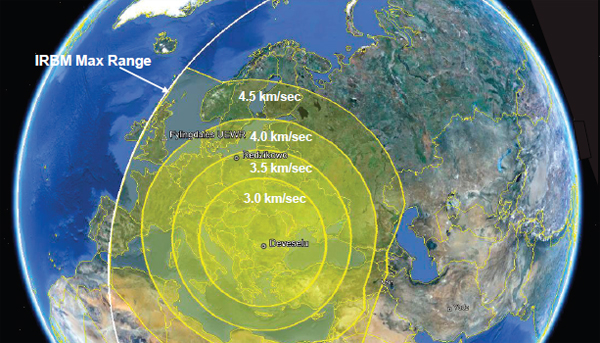
FIGURE 3-5 Notional single-shot coverage for interceptors with fly-out velocity varied parametrically between 3.0 and 4.5 km/sec against lofted trajectories from central Iran. EOR is assumed.
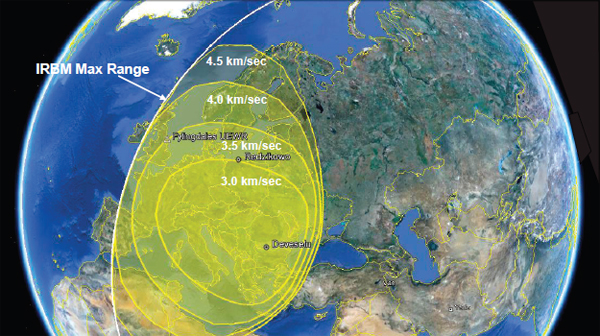
FIGURE 3-6 Notional single-shot coverage for interceptors with fly-out velocity varied parametrically between 3.0 and 4.5 km/sec against depressed trajectories from central Iran. EOR is assumed.
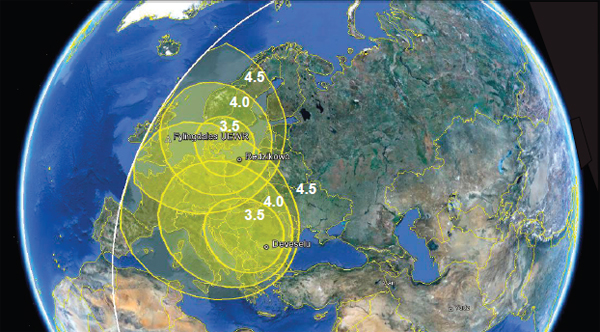
FIGURE 3-7 Notional SLS footprints against minimum energy trajectories from Iran for interceptors with fly-out velocity varied parametrically between 3.0 and 4.5 km/sec based at Deveselu, Romania, and Redzikowo, Poland. EOR is assumed.
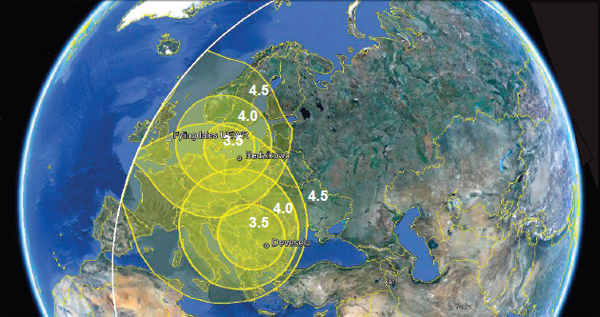
FIGURE 3-8 Notional SLS footprints against lofted trajectories from Iran for interceptors with fly-out velocity varied parametrically between 3.0 and 4.5 km/sec based at Deveselu, Romania, and Redzikowo, Poland. EOR is assumed.
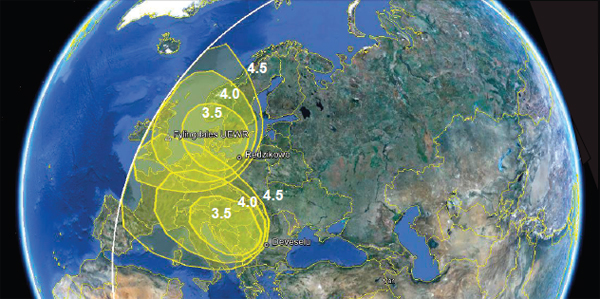
FIGURE 3-9 Notional SLS footprints against depressed trajectories from Iran for interceptors with fly-out velocity varied parametrically between 3.0 and 4.5 km/sec based at Deveselu, Romania, and Redzikowo, Poland. EOR is assumed.
(and the parallel efforts in the Middle East and northeast Asia) depend for discrimination on the integration of information from radars (notably TPY-2). While this concept is right in principle, the challenge is to accomplish discrimination in practice, as demonstrated by rigorous and realistic testing.
Northeast Asia Defense Analysis
While most of the focus to this point has been on protecting Europe from evolving ballistic missile threats from Iran, the evolution of the Aegis shipboard interceptor and its interoperability with THAAD are also applicable to defense against the significant ballistic missile threat that North Korea poses to U.S. allies and U.S. military forces in northeast Asia. Japan is the first ally to participate seriously, by jointly developing with the United States an improved Aegis SM-3 Block IIA interceptor, which figures prominently in its self-defense and in Phase 3 of the PAA architecture.
Because of the short burn times and low altitude at burnout of missiles that could target Japan and Okinawa, boost-phase defense is not practical even with the favorable engagement geometry available from Aegis ships. Therefore midcourse and terminal defenses are the only practical options available.
Figure 3-10 illustrates the single-shot footprints one can expect for interceptors with fly-out velocity varied parametrically between 3.0 and 4.5 km/sec against North Korean MRBMs (range of approximately 1,300 km), assuming EOR capability and an assumed second forward-based AN/TPY-2 radar located near Hagi, Japan, to provide accurate track data. The interceptor fly-out velocity
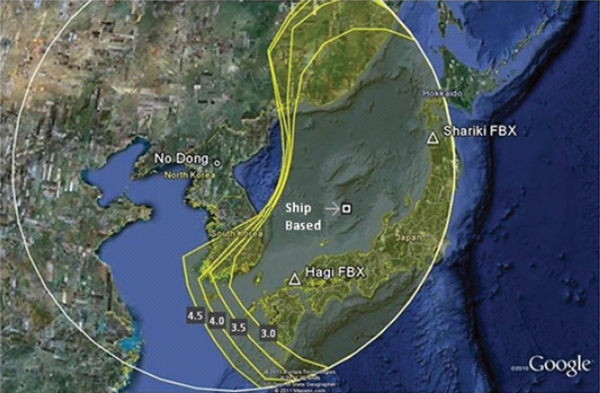
FIGURE 3-10 Notional ship-based single-shot EOR coverage of Japan: minimum energy MRBM trajectories. Note Hagi FBX location is notional and EOR is assumed.
is varied parametrically between 3.0 and 4.5 km/sec. As can be seen, notional interceptors with speeds of about 3.0 km/sec with EOR are adequate for the single-shot defense of Japan. This is less true for LOR firing doctrines, as illustrated in Figure 3-11, and less so still if stand-alone operations are considered. The LOR footprint in Figure 3-11 does not vary with interceptor speed because it is constrained by the range of the radar, not the interceptor flight speed (at least for interceptors with speeds above 3.0 km/sec). Figures 3-12 and 3-13 illustrate the single-shot EOR footprints against lofted and depressed trajectory MRBM threats, respectively. From these figures, one can see that it takes only one site (located near the center of the Sea of Japan) to provide single-shot EOR coverage for all of Japan regardless of the trajectory on which a notional 1,300 km-range liquid-propellant MRBM flies, and two sites (i.e., ships on station in two areas in the Sea of Japan) if single-shot LOR firing doctrines obtain. If one considers a more widely dispersed set of potential launch locations in North Korea, two sites will be required for complete EOR coverage of Japan, at least for the slower interceptor speeds considered here, and at least two sites in the case of LOR operation.
A shoot-look-shoot firing doctrine utilizing EOR to obtain better defense performance yields the footprints shown in Figures 3-14, 3-15, and 3-16, again assuming that a second TPY-2 radar located near Hagi is deployed for the defense of Japan. These SLS EOR footprints shrink relative to the single-shot footprints because less time is available for the second shot. Still, only two, or perhaps
three, sites are required to cover all of Japan for minimum energy and lofted trajectories. Depressed trajectories become somewhat more problematic, with at least three sites required to cover all of Japan. Therefore, SLS EOR coverage for the entire country can be provided from two or three ship-based locations in the Sea of Japan using at least two forward-based TPY-2 radars far apart on Honshu. A THAAD underlay defense can provide additional protection if desired. This should provide an effective defense of Japan against North Korean MRBMs for the foreseeable future.
Interceptor speed is not as crucial for the defense of Japan as it is for Europe, because the threat missiles are shorter range and have lower apogees. The shorter distance between North Korea and Japan means that threat missile detection can occur shortly after burnout, with accurate track data provided by two TPY-2 radars throughout the battle space. Nor is EOR as essential as in Europe, because the intercept ranges against North Korean MRBM threats directed against Japan are shorter and hence more compatible with the Aegis radar tracking capability. Hence, offboard sensors are less critical for footprint coverage.
South Korea and Western Pacific Defense Analysis
Defense of South Korea against North Korean SRBM and cruise missile threats was not analyzed in any detail in this study, but because of the short burn times, low apogees and short total flight time appear to be best provided by a combination of PAC-3 and THAAD batteries located in-country. Because North and South Korea are so close, long-range artillery is also a major threat but was not considered in the study.
Defense of forward bases at Guam (about 3,500 km from North Korea) and Okinawa (about 1,500 km from North Korea) are essentially point targets that, like Hawaii, are each best defended by local offshore Aegis ships working in conjunction with a THAAD battery ashore. The THAAD AN/TPY2 radar provides LOR or EOR data to the Aegis system for the first shot and the THAAD battery provides a second shot. This approach is discussed in the classified Appendix J, where the defense of Hawaii is examined.
In addition, TPY-2 type X-band radars located in Japan and Guam coupled with the Aegis higher performance interceptors located on or near Guam can provide SLS coverage of the entire island of Guam and an area of about 1,000 km diameter around and to the south and east of Guam against a typical MRBM threat, as shown in Figure 3-17. The blue contour line shows the SLS coverage footprint and the orange contour shows the single-shot kinematic coverage limit against a typical minimum energy North Korean MRBM. Additionally, the use of THAAD for the defense of Guam would be an excellent complement to Aegis coverage.
In summary, if also introduced as upgrades in the western Pacific along with THAAD, the Aegis evolutions currently being considered for the first three
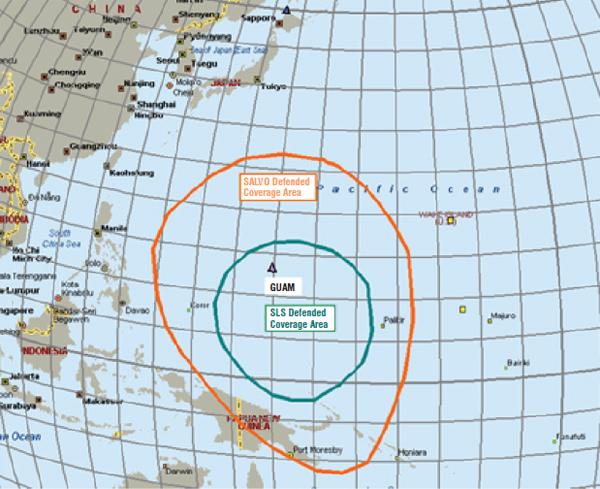
FIGURE 3-17 Defended area coverage footprint against a North Korean MRBM threat.
phases of the European PAA would provide the flexibility for defense of allies and forward bases against threats from North Korea or any other countries, limited only by the number of assets procured and deployed in the region.
FINDINGS
Midcourse Discrimination
As discussed in Chapter 2, the formidable difficulties in being able to maintain boost-phase interceptors in the necessary locations to enable defense even against long-range attacks means that any operationally feasible defense against such attacks would have to effect intercept after the boost phase is complete. While terminal defenses might serve as a useful backup protection for extremely high value (or limited area) assets, the footprint limitations of terminal defenses mean that an effective defense will usually have to occur during midcourse. In short, there is no practical missile defense system that can avoid the need for midcourse discrimination, and the midcourse discrimination problem must be addressed far more seriously if reasonable confidence is to be achieved.
Exoatmospheric discrimination, by definition, requires identifying the threatening reentry vehicle (RV) from among the cluster of other nonthreatening objects that will be visible to the defense’s sensors after the end of powered flight. Initially the nonthreatening objects may be unintentional—for example, spent upper stages, deployment or attitude control modules, separation debris, debris from unburned fuel, insulation, and other components from the booster, and the like. However, as threat sophistication increases, the defense is likely to have to deal with purposeful countermeasures—decoys and other penetration aids and tactics like salvo launches and antisimulation devices—that adversaries will have deliberately designed to frustrate U.S. defenses.
Evaluating discrimination effectiveness is an uncertain business. One should avoid overstating the ease that countermeasures that are theoretically possible can actually be made to work in practice, especially against advanced discrimination techniques using multiple phenomenologies from multiple sensors and exploiting the long observation time that midcourse intercept makes possible. It is perhaps noteworthy that the experience of the United States and the United Kingdom with the development of high-confidence penetration aids during the Cold War was a mixed success. It would be difficult for an adversary to have confidence in countermeasures without extensive testing, which the United States might be able to observe and on which it might gather data that would permit defeating the countermeasures.
Decoys are not, of course, the only countermeasures a midcourse defense system must face. Other possible measures to defeat defenses include maneuvering in midcourse and structured attacks involving simultaneous launches and/or attacks on key components of the defense, notably its sensors. As the threat evolves, defenses must adapt to these potential measures as well as to increasingly sophisticated decoy-type countermeasures. The art of midcourse discrimination, developed over many decades, does not provide perfect selection of RVs, but by designing a BMD architecture based on the capabilities described in this report, an adequate level of discrimination performance can be achieved in the near term and can give the United States a reasonable chance of keeping itself generally ahead in the contest between countermeasures and counter-countermeasures.12 The committee believes that the best approach for addressing the midcourse discrimination problem is the synergy between X-band radar observations and onboard optical sensors with a proper SLS operational concept and firing doctrine, as described below. Midcourse discrimination is discussed in greater detail in Chapter 5 as well as in classified Appendix J.
Major Finding 3: There is no practical missile defense concept or system operating before terminal phase for either the U.S. homeland or allies that does not
_____________
12There is no unequivocal answer to the question of whether a missile defense can work against countermeasures. It depends on the resources expended by the offense and the defense and the knowledge each has of the other’s systems. Thus, defense effectiveness against countermeasures inevitably will vary with time as the offense-defense competition unfolds.
depend on some level of midcourse discrimination, even in the absence of deliberate decoys or other countermeasures. The only alternative is to engage all credible threat objects (the Multiple Kill Vehicle program was such a hedge). Therefore it is important to face the problem of midcourse discrimination squarely and to maximize the probability of accomplishing it.
• Initially the nonthreatening objects may be “unintentional”—for example, spent upper stages, deployment modules or attitude control modules, separation debris, debris from unburned fuel, insulation, and other parts of the booster. However, as threat sophistication increases, the defense is likely to have to deal with purposeful countermeasures—decoys and other penetration aids and tactics including salvo launches and antisimulation devices—that adversaries will have deliberately designed to frustrate U.S. defenses.
• The midcourse discrimination problem must be addressed far more seriously if reasonable confidence is to be achieved.
Major Finding 4: The synergy between X-band radar observations and concurrent optical sensor observations on board a properly designed interceptor (which could be a modified ground-based interceptor) closing on the target complex has not been exploited. The committee believes a combination of a proper operational concept and firing doctrine taking advantage of the battle space available for SLS offers the greatest potential for effective discrimination in the face of potential future countermeasures. Although it is by no means a certain solution, the committee believes this approach is not adequately exploited in current U.S. midcourse defense systems (such as GMD) and needs to be if the United States is to have an effective defense against limited attacks.
• The importance of this three-way synergy—X-band radar observations concurrent with optical sensor observations on board a properly designed interceptor together with SLS capability—cannot be overemphasized.
• This will require implementing a more realistic and robust program to gather data from flight tests and experiments (including on flights of U.S. missiles) from the full range of sensors, and making full use of the extensive data collected from past experiments to continue developing the applied science from which robust discrimination techniques and algorithms can be developed.
Major Finding 5: Based on information presented to the committee, it does not appear that MDA takes into account how the signatures of various threat objects behave when observed concurrently for several hundred seconds by both interceptor-mounted optical sensors closing on the threat complex and X-band radar measurements. Moreover, it appears that virtually all of the effective analytical work at MDA in optical signatures was terminated several years ago, ostensibly for budget reasons. The Midcourse Space Experiment (MSX) and the High-Altitude Observatory 2 (HALO-2) programs, for example, provided signifi-
cant amounts of useful data. Yet the committee could not find anyone at MDA who could show it those data or explain them let alone the data from ground-based interceptor flight tests.
• Forty years of optical signature data from well-instrumented past and recent flight tests are lying fallow and unanalyzed with respect to current technological capabilities. These include programs with acronyms such as designating optical tracker (DOT), fly-along infrared (FAIR), the Homing Overlay Experiment (HOE), the Queen Match Discrimination Experiment, and others.
• While radar and optical midcourse discrimination technologies have been pursued for years, they have largely been on separate tracks and more in competition than in collaboration.
Homeland Defense
The GMD system at FGA and VAFB was deployed before its development was complete in order to meet what was considered an urgent need to get a system deployed quickly. As a result, GMD could not benefit from a normal development cycle, and it evolved in an environment of changing requirements, with the end result that it is limited in its ability to perform the U.S. homeland defense mission.
The current GMD architecture does not take advantage of technically available means of discrimination or of effective engagement doctrine, but it could be modified to do so. Its shortcomings are not limited to concerns about discrimination. The GMD interceptors are very expensive ($70 million to $86 million FY 2010 dollars) even in comparison with other non-BMD weapon systems of comparable size and complexity. To the extent the firing doctrine for GMD would rely on firing salvos the expense can be even greater. Other limitations in the current GMD system are discussed in classified Appendix J.
Significant but feasible and affordable upgrades are needed to the GMD system and its configuration and supporting facilities if it is to be genuinely capable of its stated mission of protecting all of the U.S. homeland against the sort of long-range missile attack that North Korea and Iran may be able to mount in the next decade or so if they press their development programs forward. Specific upgrades are provided in Chapter 5.
Major Finding 6: To be credible and effective, any ballistic missile defense system must be robust even if any of its elements fail to work as planned, whether that failure is due to a failure of discrimination or to something else. Moreover, a properly configured midcourse defense is the most cost-effective and resilient method of defending the U.S. homeland against ballistic missile attack. What is needed is a system that is resilient to failure, in particular the failure to discriminate successfully. This implies making use of SLS doctrine that exploits the potential battle space. The committee has analyzed the effectiveness of the discrimination capability of the GMD system and finds that the system can, if it
works as designed, deal successfully with the initial threats from North Korea. However, the current GMD system has been developed in an environment of limited objectives (e.g., dealing with an early-generation North Korean threat of very limited numbers and capability) and under conditions where a high value was placed on getting some defense fielded as quickly as possible, even if its capability was limited and the system less than fully tested. As a result, the GMD interceptors, architecture, and doctrine have shortcomings that limit their effectiveness against even modestly improved threats and threats from players other than North Korea. Nevertheless, 30 GMD interceptors exist (or soon will), and they and their support network of sensors—including additional properly chosen and located and already fully developed ground-based forward X-band radar elements—and communications could, at an affordable cost and on a timeline consistent with the expected threat, be modified, emplaced, and employed so as to be far more effective for the homeland defense mission.
• The foundation for these modifications has already been laid by MDA.
• For example, GMD interceptors require a Block II ground-based interceptor incorporating KEI-like booster technology having a shorter burn time and a new kill vehicle with talk-back capability to permit using downlinked information from a closing kill vehicle.
Defense of Deployed Forces, U.S. Allies, Partners, and Host Nations
The MDA and the Services appear to be on the right track for developing BMD systems for countering short-, medium-, and intermediate-range ballistic missile threats from rogue states to deployed forces and U.S. allies, partners, and host nations. However, while Aegis, THAAD, and PAC-3 are well developed and suited to their individual missions against these types of threats, there has been limited interface among them.
Major Finding 7: The Aegis ship-based SM-3 Block II interceptors with launch or engage on remote—both of which capabilities are under development—together with the THAAD and PAC-3 systems and their elements will provide, where appropriate, adequate coverage for defense of U.S. and allied deployed forces and of Asian allies.13
• With two or three Aegis ashore sites in Europe, that same combination can provide a layered late midcourse and high-altitude terminal defense for Europe.
_____________
13In the LOR concept, the engagement is controlled and in-flight target updates are provided from the launching ship. The Aegis program is also working to develop an EOR capability by 2015, whereby (1) the interceptor can be launched using any available target track and (2) engagement is controlled from and in-flight target updates can be provided to the interceptor missile from any Aegis AN/SPY-1 or AN/TYP-2 radar. The committee applauds the MDA’s progress in achieving LOR capability for Aegis.
• No interceptor with fly-out speeds less than or equal to 5.0 km/sec based in Poland or Romania or elsewhere in Europe can engage or interfere with Russia’s nuclear deterrent ICBMs or submarine-launched ballistic missiles.
• Coverage of Israel and other Middle East areas against the anticipated threat will require additional Aegis and THAAD assets. (Turkey will require its separate defense using THAAD or the equivalent against shorter-range threats.) These requirements assume that single-shot defense of most areas is acceptable.
• Universal SLS capability, which is desirable for effective discrimination and other purposes, will require additional sites or terminal defense.
Major Finding 8: The first three phases of the European Phased Adaptive Approach (PAA) are expected to provide defense for Europe against a limited ballistic missile attack for deployed U.S. and allied forces within the region and the Middle East, provided the sensor architecture and the missile defense command and control (C2) center for the European PAA architecture can implement engage-on-remote capability.
• If modestly sophisticated countermeasures are anticipated for the IRBM threat, then the European PAA will need to include multiple X-band radar and long-range IR sensors (e.g., ABIR) that can provide concurrent data on IRBM trajectories similar to the countermeasures proposed for U.S. national missile defense. However, the IR data will need to come from external sensors because the SM-3 and THAAD kill vehicles have limited seeker range and limited divert capability. Fortunately, Aegis and THAAD are both capable of continuous communication between the kill vehicle and the C2 center.
• Europe can be covered with a SLS firing doctrine assuming enough sites are deployed, where the number of sites required depends on the interceptor speed—for example, two or three sites would be required if the interceptor speed is greater than 5.0 km/sec.
• SLS, when combined with the sensor architecture and C2 center noted above, is expected to provide a relatively robust defense of Europe against a range of potential future countermeasures.
• Turkey, as a member of NATO, will require separate BMD elements to ensure its protection. THAAD is probably the most appropriate system for this purpose owing to the stand-alone capability of its X-band radar and its ability to intercept shorter range missiles.
Major Finding 8a: Phase IV of the European PAA may not be the best way to improve U.S. homeland defense.
• The speed of the Phase IV interceptor will need to be greater than can be achieved with a 21-in. missile to avoid being overflown by lofted ICBM trajectories from Iran if the interceptor is based in northern Europe (Poland).



































